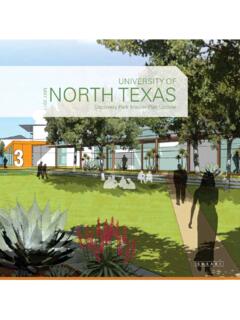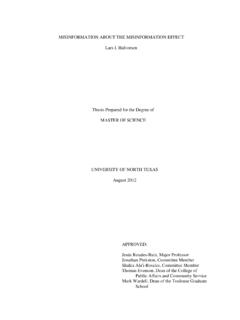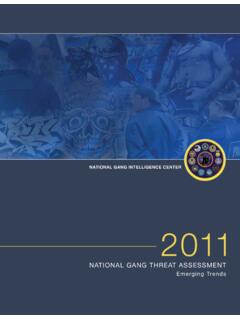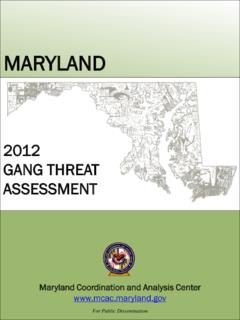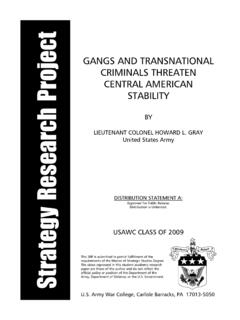Transcription of Gangs in Central America - Digital Library
1 CRS Report for CongressPrepared for Members and Committees of Congress Gangs in Central America Clare Ribando Seelke Specialist in Latin American Affairs January 28, 2013 Congressional Research Service 7-5700 RL34112 Gangs in Central America Congressional Research Service Summary Congress has maintained an interest in the effects of gang violence in Central America , and on the expanding activities of transnational Gangs with ties to that region operating in the United States. Since FY2008, Congress has appropriated significant amounts of funding for anti- gang efforts in Central America , as well as domestic anti- gang programs. Two recent developments may affect congressional interest in Central American Gangs : a truce between rival Gangs has lowered violence in El Salvador, and the Treasury Department has designated the Mara Salvatrucha (MS-13) as a significant transnational criminal organization (TCO). MS-13 and its main rival, the 18th Street gang (also known as M-18), continue to threaten citizen security and challenge government authority in Central America .
2 gang -related violence has been particularly acute in Honduras, El Salvador, and Guatemala, which have had among the highest homicide rates in the world. Recently, some governments have moved away from repressive anti- gang strategies, with the government of El Salvador now facilitating a historic and risky truce involving the country s largest Gangs . The truce has contributed to a large reduction in homicides since March 2012, but robberies, assaults, and extortions have continued. The truce carries risks for the Salvadoran government, such as what might happen if the Gangs were to walk away from the truce stronger, better organized, and with more political clout. agencies have been engaged on both the law enforcement and preventive sides of dealing with Central American Gangs ; an inter-agency committee developed a Strategy to Combat Criminal Gangs from Central America and Mexico that was first announced in July 2007. The strategy focuses on diplomacy, repatriation, law enforcement, capacity enhancement, and prevention.
3 An April 2010 study by the Government Accountability Office (GAO) recommended that agencies consider strengthening the anti- gang strategy by developing better oversight and measurement tools to guide its implementation. law enforcement efforts may be bolstered by the Treasury Department s October 2012 decision to designate and sanction MS-13 as a major TCO pursuant to Executive Order ( ) 13581. In recent years, Congress has increased funding to support anti- gang efforts in Central America . Between FY2008 and FY2012, Congress appropriated roughly $35 million in global International Narcotics Control and Law Enforcement (INCLE) funds for anti- gang efforts in Central America . Congress provided additional support in FY2008 and FY2009 for anti- gang efforts in the region through the M rida Initiative, a counterdrug and anticrime program for Mexico and Central America , and, more recently, through the Central American Regional Security Initiative (CARSI).
4 Congressional oversight may focus on the efficacy of anti- gang efforts in Central America ; the interaction between domestic and international anti- gang policies, and the impact of the Treasury Department s TCO designation on law enforcement efforts against MS-13. This report describes the gang problem in Central America , discusses country and regional approaches to deal with the Gangs , and analyzes policy with respect to Gangs in Central America . Also see CRS Report R41731, Central America Regional Security Initiative: Background and Policy Issues for Congress, by Peter J. Meyer and Clare Ribando Seelke. Gangs in Central America Congressional Research Service Contents Introduction .. 1 Scope of the gang Problem in Central America .. 1 Defining Gangs .. 1 Gangs in Central America .. 2 Factors Exacerbating the gang Problem in Central America .. 6 Poverty and a Lack of Educational and Employment Opportunities .. 6 Societal Stigmas.
5 6 Role of the Media .. 6 Anti- gang Law Enforcement Efforts .. 7 Prisons in Need of Reform .. 7 Deportations to Central America and the gang Problem .. 7 Country Anti- gang Efforts .. 9 Mano Dura (Heavy-Handed) Anti- gang Policies .. 9 Military Involvement in Public Security .. 10 Approaches in Other Central American Countries .. 11 gang Truce in El Salvador .. 11 Prospects for Country Prevention and Rehabilitation Efforts .. 13 Policy .. 14 Congressional Interest and Appropriations for Anti- gang and Related Security Efforts in Central America .. 15 Evolution of International Anti- gang Efforts .. 16 State Department .. 17 Department of Justice .. 18 Immigration and Customs Enforcement (ICE) .. 19 Agency for International Development (USAID) .. 19 Treasury Department .. 20 Possible Questions for Oversight .. 20 Figures Figure 1. Estimated gang Membership in the Northern Triangle of Central America , 2012 .. 4 Ta b l e s Table 1.
6 Deportations to Top Receiving Countries: FY2009-FY2011 .. 8 Contacts Author Contact 21 Gangs in Central America Congressional Research Service 1 Introduction In recent years, analysts and officials have expressed ongoing concerns about the increasing rates of violent crimes committed by drug traffickers, organized criminal groups, and Gangs in Central Central American governments, the media, and some analysts have attributed a significant proportion of violent crime in that region to youth Gangs or maras, many of which have ties to the United States. concerns about Gangs have accelerated as the Mara Salvatrucha (MS-13), a particularly violent group with ties to Central America , has increased its presence and illicit activities in the United Policy-makers in countries throughout the region, including in the United States, are struggling to find the right mix of suppressive and preventive policies to confront the gang problem.
7 Most agree that a comprehensive, regional approach to Gangs is necessary to prevent further escalation of the problem. Congress is likely to maintain an interest in crime and gang violence in Central America , as well as the related activities of Central American Gangs in the United States. In recent years, Congress has considered what level of assistance is most appropriate to help Central American countries combat gang activity and what types of programs are most effective in that effort. Members of Congress have also taken an interest in the impact of deportations of individuals with criminal records to Central America on the gang problem, as well as the evolving relationship between Mexican drug trafficking organizations and the Gangs . More recently, there has been congressional interest in the gang truce in El Salvador and the potential implications that its success or failure might have for anti-crime efforts in other countries.
8 In the coming year, Congress may also examine how anti- gang efforts have been affected by the Treasury Department s October 2012 decision to designate and sanction the MS-13 as a significant Transnational Criminal Organization (TCO).3 This report describes the gang problem in Central America , discusses country approaches to deal with the Gangs , and analyzes policy with respect to Gangs in Central America . It concludes with possible questions for oversight that Congress may consider. Scope of the gang Problem in Central America Defining Gangs Academics and other experts on Gangs continue to debate the formal definition of the term gang and the types of individuals that should be included in definitions of the term. There is general agreement that most Gangs have a name and some sense of identity that can sometimes be 1 The Central American countries include Belize, Costa Rica, El Salvador, Guatemala, Honduras, Nicaragua, and Panama.
9 This report focuses on the northern triangle countries of Central America where the gang problem has been most acute, which include El Salvador, Guatemala, and Honduras. It refers to the other countries and governments in the region periodically for comparative purposes. For more information, see: CRS Report R41731, Central America Regional Security Initiative: Background and Policy Issues for Congress, by Peter J. Meyer and Clare Ribando Seelke. 2 Department of Justice, National gang Intelligence Center, National gang Threat assessment (NGTA) 2011: Emerging Trends, 2011. 3 Department of Treasury, Treasury Sanctions Latin American Criminal Organization, press release, October 11, 2012. Gangs in Central America Congressional Research Service 2 indicated by symbols such as clothing, graffiti, and hand signs that are unique to the gang . Gangs are thought to be composed of members ranging in age from 12 to 24, but some gang members are adults well over the age of 24.
10 Typically, Gangs have some degree of permanence and organization and are generally involved in delinquent or criminal activity. Gangs may be involved in criminal activities ranging from graffiti, vandalism, petty theft, robbery, and assaults to more serious criminal activities, such as drug trafficking, drug smuggling, money laundering, alien smuggling, extortion, home invasion, murder, and other violent felonies. The lines between transnational gang activity and organized crime are increasingly blurry. Gangs generally feature horizontal power structures, with many small subgroups (semi-independent franchises ) and limited Central leadership setting strategy and enforcing discipline. While many Gangs lack the organizational structure, capital, and manpower required to run sophisticated criminal schemes or to penetrate state institutions at high levels, some (such as the MS-13 and the 18th Street) have become more highly In Central America , Gangs are often involved in the street-level distribution of drugs and in extortion rackets, but MS-13 may also be involved in higher-level criminal drug When referring to Gangs in Central America , some studies use the term pandillas and maras interchangeably, while others distinguish between the Studies that make a distinction between the two types of Central America Gangs generally define pandillas as localized groups that have long been present in the region, and maras as a more recent phenomenon that has some transnational roots.
